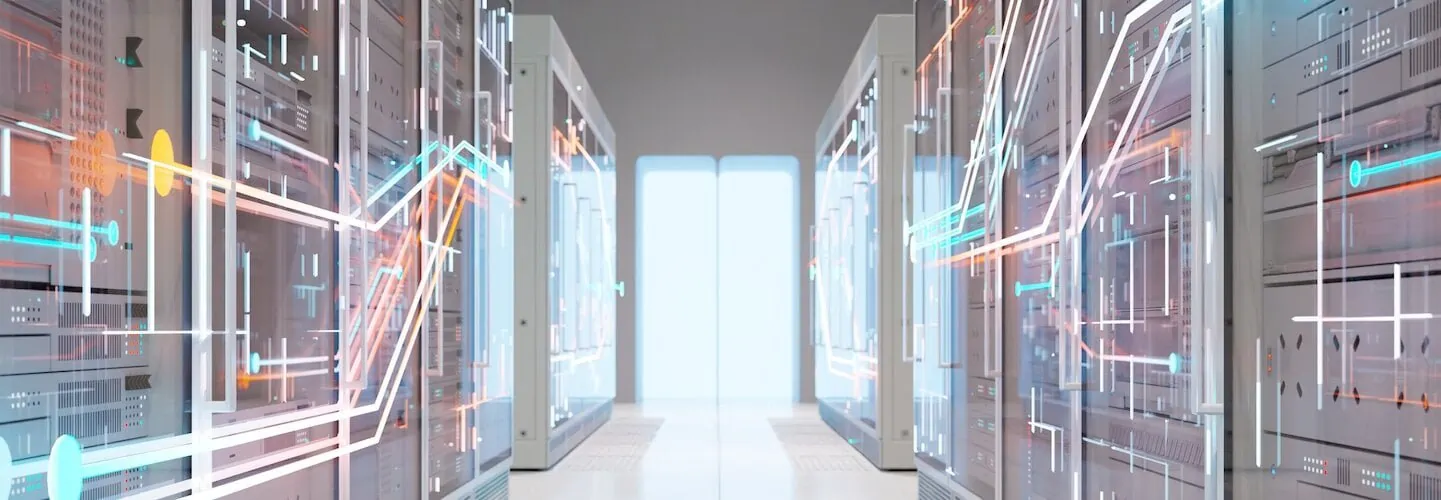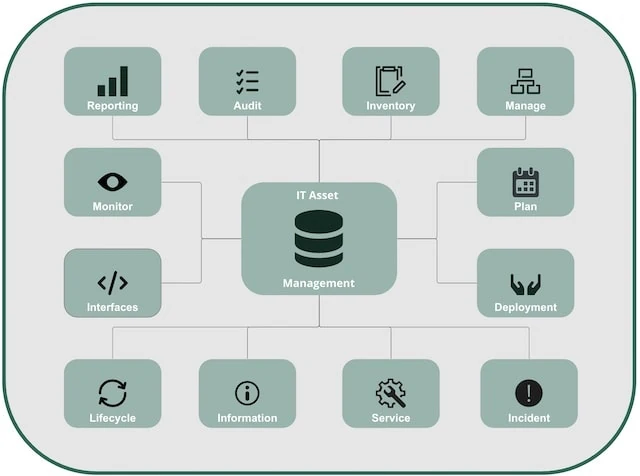

What is IT Asset Management?
The task of IT asset management (ITAM) is to ensure smooth operation and service throughout the entire asset lifecycle by systematically managing assets and avoiding unnecessary costs in IT service management.
IT asset management is not limited simply to the management of hardware, but also includes software, licenses, and all other important information about the operation of services provided and management of a businesses’ IT organization.
As a rule, ITAM is operated by a specialized team and is a central component of a company’s IT Service Management (ITSM).
What is an IT asset?
By definition, IT assets are all components and information in IT. An IT asset is an asset that is used by a company to maintain or improve its business operations. This includes, for example, computers, software, networks, and all data associated with IT assets.
Assets in IT:
- Hardware (servers, computers, phones, printers, scanners, copiers, etc…).
- Software, licenses and contracts
- All the necessary information to ensure IT operations.
Why IT Asset Management?
IT is one of the main pillars of a company. Business processes, value creation and management are hardly conceivable today without the use of IT components.
Even in smaller companies, the number of IT assets to be managed can quickly reach a chaotic level without well-established IT asset management. IT processes can quickly become inefficient and cause high costs.
IT assets often have a specific lifecycle and depreciation periods that must be observed to avoid an increased risk of operational failures and unnecessary costs. Hardware is replaced with new hardware at the end of its life. Software licenses must be renewed; access rights must be assigned to employees or revoked when necessary.
Such complex processes for hundreds of IT assets and employees cannot be managed efficiently without IT asset management. In the worst case, the quality of support will suffer, or there will be a reduction in productivity.
The basis for successful IT asset management is the central collection of information and the efficiency in implementing IT activities.Bernd Maus
Benefits of IT asset management
-
Transparency:
With an overview of all IT assets, you always have an overview of failures, peak loads, runtimes, and depreciation periods. The costs of the company’s entire IT assets are thus available, and these can facilitate management decisions.
-
Efficiency:
All IT assets are managed centrally. Information on the assets is recorded and corresponding measures and services can be carried out in a coordinated manner without disrupting operations more than is necessary. This ensures service quality, creates satisfied employees and conserves resources.
-
Information security:
Important data on hardware and software, as well as on IT operations, can be managed centrally in conjunction with an information security management system (ISMS). This prevents information silos, inefficiency and risks.
-
Increased operational security:
Access authorizations, life cycles, operating time and systematic problems with IT assets are securely recorded by central management – only then can appropriate measures be taken and risks minimized.
What does IT Asset Management involve?
Hardware Asset Management (HAM)
An essential component of IT asset management is hardware asset management. The main aim here is to ensure that all hardware components in a company are used correctly, maintained regularly and renewed. Maintenance and life cycles are defined, thus minimizing potential risks due to failure. A structured overview of the available hardware assets avoids superfluous hardware and software, and IT service resources can be deployed in the best possible way.
Software Asset Management (SAM)
With software asset management, companies ensure that they always keep the licenses of all software up-to-date and only purchase the required number of licenses
Compliance in Asset Management
Compliance, and thus adherence to regulations and guidelines, is often obligatory for a company in order to avoid high fines and penalties. Demonstrating a culture of compliance can point to the quality the company’s management when viewed by external parties. Compliance asset management helps companies monitor and ensure compliance.
Information Management in Asset Management
Asset information management bundles data from various information sources and systems. Documents, drawings and other data formats are reliably captured and made available for further use in a central location.

IT Asset Management Software
IT Asset Management Software (ITAM Software) is an indispensable tool for successfully handling a company’s IT asset management. It provides all necessary information about the assets and helps to manage these. Extensive reporting functions on downtimes, lifecycles and costs help management to make the right decisions and effectively allocate resources for support and services.
Important IT Asset Management Software Features
-
Inventory of IT assets in a CMDB
The inventory of IT related assets is one of the most important functions of IT asset management software. All IT assets of the company are recorded and visible in a detailed inventory database.
The configuration management database (CMDB) is a fundamental component of IT asset management software. In the database, all IT assets are recorded as configuration items (CI) and can be displayed with the corresponding information, dependencies and reminder functions.
.
-
IT asset management
A variety of functions must be available in IT asset management software to efficiently manage, monitor and protect an organization’s IT assets.
-
- Planning
- Deployment
- Maintenance
- Service Management
- Lifecycle Management
- Incident Management
- Business Process Management
In order to perform the corresponding administrative tasks securely and with consistent quality, ITSM processes are required to ensure that the necessary services are maintained and information is recorded or retrieved throughout all phases of an IT asset’s lifecycle: This is the only way to optimize the use of assets, record costs and ensure operational reliability.
-
Monitoring of IT assets
One of the requirements of IT asset management is the early detection of hardware and software problems. Configurable threshold values and the bundling of information attached to IT assets enable early countermeasures and the provision of support services. At the same time, it is also possible to recognize when support requests for specific assets happen more frequently than normal.
-
Reporting
With integrated reporting, an number of operational topics can be evaluated: load peaks, operating hours, life cycles, incidents and costs of individual assets or entire asset groups. This is the only way to ensure efficient IT asset management.
-
Information management
All information related to the assets, such as suppliers, contracts, conditions, or manuals, are managed centrally and can therefore be accessed at any time.
-
Audit-proof and audit-capable
The complete tracking of all asset management processes and communication, as offered by OTRS, is the basis for audits and necessary certifications. This creates trust among employees, customers and investors.
-
Interfaces
Interfaces, such as to an information security management system or an integrated ITAM tool in ITSM software, are a prerequisite for the exchange of data and prevent information silos.
IT Asset Management Software from OTRS
OTRS is the perfect partner for handling your IT Asset Management. Contact our experts.
Categories
- About OTRS Group (21)
- Automation (3)
- Corporate Security (26)
- Customer Service (31)
- Developing a Corporate Culture (12)
- Digital Transformation (53)
- General (79)
- ITSM (31)
- Leadership (22)
- OTRS in Action (8)
- Processes (5)
- Using OTRS (14)
